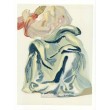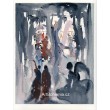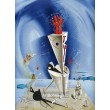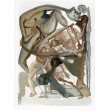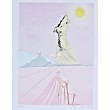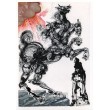Košík
0
x
Produkty
(prázdný)
Žádné díla
Bude determinováno
Dopravné a balné
0 Kč
Celkem
Produkt byl úspěšně přidán do nákupního košíku
Počet
Celkem
0 ks zboží.
1 dílo v košíku.
Za díla:
Doručení a balné:
Bude determinováno
Celkem
Kategorie
- grafiky/tisky
- obrazy
- kresby
- plakáty
- fotografie
- exlibris
- bibliofilie
- knihy/katalogy
- starožitnosti
- sochy/plastiky
- sklo
-
Hnutí
- abstrakce
- art-deco
- čs.avantgarda/moderna
- expresionismus
- fauvismus
- impresionismus
- kubismus
- naivní umění
- op-art
- poetismus
- pop-art
- realismus
- secese
- sociální kritika
- soudobá tvorba
- surrealismus
- světová avantgarda/moderna
- Škola prof. Albína Brunovského
- Škola prof. Zdeňka Sklenáře
- Škola prof.Julia Mařáka - mařákovci
- Žánr
- Zprávy/NEWS
- Doporučujeme
Nová díla
-

Zpívající ptáček velký, opus 725a
5 203 Kč -

Ňadro s optikou
2 178 Kč -

Ptáček v oblacích
1 452 Kč
-

Kopec s vlajkou - PF 1983 Kamil Lhoták
2 396 Kč -10% 2 662 Kč
Hnutí
- abstrakce
- art-deco
- čs.avantgarda/moderna
- expresionismus
- fauvismus
- impresionismus
- kubismus
- naivní umění
- op-art
- poetismus
- pop-art
- realismus
- secese
- sociální kritika
- soudobá tvorba
- surrealismus
- světová avantgarda/moderna
- Škola prof. Albína Brunovského
- Škola prof. Zdeňka Sklenáře
- Škola prof.Julia Mařáka - mařákovci
Žánr
NEJŽÁDANĚJŠÍ UMĚLCI
- Anderle Jiří
- Augustovič Peter
- Benca Igor
- Beneš Karel
- Bím Tomáš
- Born Adolf
- Brun Robert
- Brunovský Albín
- Boštík Václav
- Bouda Cyril
- Bouda Jiří
- Braque Georges
- Brázda Jiří
- Buffet Bernard
- Cézanne Paul
- Čapek Josef
- Čápová Hana
- Dalí Salvador
- Demel Karel
- Dudek Josef
- Dufy Raoul
- Effel Jean
- Felix Karol
- Filla Emil
- Giacometti Alberto
- Grosz George
- Chagall Marc
- Istler Josef
- Janeček Ota
- Jiřincová Ludmila
- Kandinsky Wassily
- Kĺúčik Peter
- Komárek Vladimír
- Kulhánek Oldřich
- Kupka František
- Lada Josef
- Lhoták Kamil
- Matisse Henri
- Miró Joan
- Mucha Alfons
- Muzika František
- Picasso Pablo
- Pileček Jindřich
- Reynek Bohuslav
- Sukdolák Pavel
- Suchánek Vladimír
- Svolinský Karel
- Šíma Josef
- Špála Václav
- Švabinský Max
- Švengsbír Jiří
- Tichý František
- Toulouse-Lautrec Henri de
- Toyen
- Trnka Jiří
- Váchal Josef
- Vik Karel
- Warhol Andy
- Zábranský Vlastimil
- Zoubek Olbram
- Zrzavý Jan
Seznam děl umělce Dalí Salvador
Salvador Dali was originally a Cubist but became a Surrealist in 1929. He was welcomed into the group by Breton, who, in 1938, expelled him. Dalí abandoned the implicit Marxism of the "official" Surrealist while continuing to exploit Freudian imagery.
Salvador Dali was originally a Cubist but became a Surrealist in 1929. He was welcomed into the group by Breton, who, in 1938, expelled him. Dalí abandoned the implicit Marxism of the "official" Surrealist while continuing to exploit Freudian imagery.
His is the nightmare world of man-size ants and limp pocket watches, meticulous in realistic detail, haunting in the inescapability of the horrific and even in his religious works, such as the Glasgow Crucifixion, unable to avoid the crude sensationalism of willful shock.
Perhaps his best works, in their extraordinary mixture of wild imagery and precise execution, are his pieces of jewelry, where the fantastic is enhanced by being allied successfully to precious materials.
He was in the United States between 1940 and 1955 when he returned to Spain. Many of his works are in American museums.
He has written extensively about himself.
In: http://www.centaurgalleries.com/Artists/Artist.cfm?ArtistID=00036
Dalí (Domènech), Salvador (Felip Jacint)
(b Figueres, 11 May 1904; d Figueres, 25 Jan 1989). Spanish Catalan painter, draughtsman, illustrator, sculptor, writer and film maker. One of the most prolific artists of the 20th century, his fantastic imagery and flamboyant personality also made him one of the best known. His most significant artistic contribution, however, was through his association with SURREALISM.
There are more than 45,000 articles in The Grove Dictionary of Art. To access the rest of this article, including the bibliography, subscribe to www.groveart.com. To find out more about this subject, click on a related article below and subscribe to www.groveart.com
In: http://www.artnet.com/library/02/0211/T021196.asp
Grand master of provocation, virtuoso of the eccentric, Salvador Dali is known the world over. The artist dominated his time by occupying a major place in the world of Surrealism, but Dali was also a specialist in keeping up with the times.
Art fans and critics were often taken off-guard by the artist’s position as well as his paintings. Dali knew how to interpret the world’s subconscious and would coin the famous phrase “paranoia critique”, a concept that he would use to explain the meaning of his works. The deliberate exploitation of all things delirious, enhanced by a certain mystical eroticism are also integral parts of Dali’s quest.
The artist often associated the absurd with a situation or perspective depicting the cosmos: with a classic artistic beauty, concrete details reveal an underlying tension – sometimes thanks to specific lighting. The effect obtained is nothing less than startling.
Dali collaborated with famous film maker Luis Bunuel, created jewelry and illustrated several books. His excessive tendency towards exhibitionism, supported by a strong penchant to invent, the diversity of the various genres he dabbled in and the techniques that Dali needed to succeed, all make him one of the most extraordinary figures on the 20th century art scene.
http://www.operagallery.com/artist/DALI_448;0;0.aspx
Dalí, Salvador (1904-1989), Spanish painter, writer, and member of the Surrealist movement. He was born in Figueras, Catalonia, and educated at the School of Fine Arts, Madrid. After 1929 he espoused Surrealism, although the leaders of the movement later denounced Dalí as too commercial. Dalí's paintings from this period depict dream imagery and everyday objects in unexpected forms, such as the famous limp watches in The Persistence of Memory (1931, Museum of Modern Art, New York). Dalí moved to the United States in 1940, where he remained until 1948. His later paintings, often on religious themes, are more classical in style. They include Crucifixion (1954, Metropolitan Museum, New York) and The Sacrament of the Last Supper (1955, National Gallery of Art, Washington, D.C.).
Dalí's paintings are characterized by meticulous draughtsmanship and realistic detail, with brilliant colours heightened by transparent glazes. Dalí designed and produced Surrealist films, illustrated books, designed jewellery, and created theatrical sets and costumes. Among his writings are ballet scenarios and several books, including The Secret Life of Salvador Dalí (1942) and Diary of a Genius (1965).
In: MS Encarta
Salvador Dali, the famous Spanish surrealist, is considered to be one of the masters of 20th century art. His artwork displays a meticulous academic technique that is contradicted by depictions of hallucinatory characters in an unreal ‘dream’ space. He described his art as `hand-painted dream photographs' and had certain favorite and recurring images, such as the human figure with half-open drawers protruding from it, burning giraffes, and watches bent and flowing as if made from melting wax.
Salvador Domenec Felip Jacint Dalí Domenech was born May 11, 1904 in Figueras, Catalonia, Spain. He and his sister enjoyed a comfortable upbringing in the Mediterranean climate with a sympathetic mother and a successful father. His father, a prominent notary, encouraged his son’s artistic inclinations and set him up with drawing lessons at age ten from well known Spanish impressionist painter, Ramon Pichot, Later in 1923, Dali’s father bought him his first printing press.
In 1922 Salvador Dali moved to Madrid to study painting at the Academy of Arts. He developed a reputation as an eccentric, attracting attention with his manner of dress, hairstyles, and provocative comments on art. The artist experimented with forms of Cubism and Dadaism during his studies. Dali was expelled before final exams, after asserting that those judging his work were not competent enough to grade him.
After leaving the Academia, Dali went to Paris where he met Spanish painters Pablo Picasso and Joan Miro. He established himself as the principal figure of a group of surrealist artists grouped around French poet Andre Breton. The surrealists hailed what Dalí called the Paranoiac-critical method of accessing the subconscious for greater artistic creativity. Essentially, it is the ability of the artist or the viewer to perceive multiple images within the same configuration and a process through which Dali found new and unique ways to view the world around him. Years later Breton turned away from Dali accusing him of support of fascism, excessive self-presentation and financial greediness. He was officially expelled from the group in 1934, in part because of his controversial political views, and was henceforth spoken about by the surrealists in past-tense, as if he were dead. Brenton later coined the nickname Avida Dollars for Dali, an anagram of his name meaning “greedy for dollars”.
In addition to Surrealism, psychologist Dr. Sigmund Freud’s theory of the unconscious, introduced to Dalí in Freud's book `The Interpretation of Dreams', also strongly influenced Dali’s work and philosophy. Throughout the 1920s and early 1930s Dali perfected the personal style that made him famous-- the world of the unconscious that is recalled during our dreams. In his work, he’d juxtapose incongruous, unrelated, and often bizarre objects against desolate landscapes. This disturbing blend of precise realism and dreamlike fantasy became his hallmark.
In 1929, Dali met his future-wife Gala. Gala (born Elena Ivanovna Diakonova), a Russian immigrant eleven years his senior, was then married to the surrealist poet Paul Éluard. Dali and Gala were married in a civil service in 1934, and again in a church after Eluard’s dealth. Gala was Dali’s muse, inspiration, lover, and model, as well as his business manager. Most importantly, she was his constant companion and the stabilizing factor in his life.
In 1933, Salvador Dali had his first one-man show in New York. Thanks to a $500 loan from Pablo Picasso, Dali was able to visit the United States for the first time a year later. In the late 1930s, he made several trips to Italy to study the art of the sixteenth and seventeenth centuries and became a great admirer of Italian Renaissance painter Raphael.
In 1940, Dali and Gala claimed permanent residency in the US in order to evade World War II. During his eight years in the US, Dali had a series of spectacular exhibitions, including a retrospective show at the Museum of Modern Art in New York. Dali became a great success in the United States. He understood how the media worked and used it to its full potential. His attention seeking comments and flamboyant appearance helped raise him to celebrity status. He executed portraits commissioned by celebs like Helena Rubinstein or Jack Warner, designed jewelry for Coco Channel and even worked with Walt Disney on an animated film. Dalí was a colorful and imposing presence in his ever-present long cape, walking stick, haughty expression, and upturned waxed mustache. He once famously said that "every morning upon awakening, I experience a supreme pleasure: that of being Salvador Dalí."
In 1948 Dali and Gala returned to Europe, and split their time between their residences in Llgait, Spain and Paris or New York. In the 1940s and 1950s, Dali explored his interests in science, religion and history and began integrating more traditional and universal themes in his work. During this “classic” period, he developed his ideas into the concept of Nuclear Mysticism, which surmises that science and religion are in fact harmonious. His theories weren’t exactly ground breaking, or particularly new, but Dali, always a master of appearances, marketed them as such.
Dalí had been producing limited edition prints since the 1930s, but the images he created in the 1960s with publishers Sidney and Phyllis Lucas are considered the cream de la cream of Dalí lithographs. His publishers encouraged the incorporation of classical themes with Surrealism, and together they assembled fascinating graphic works.
After his beloved wife Gala died in 1982, Dali's health deteriorated. His heartbreak was compounded by a debilitating condition of palsy, and injuries from a suspicious fire in his Pubol castle in 1984. The end of his life was spent in seclusion, first in Pubol and later in his apartments at Torre Galatea, adjacent to the Teatro Museo. Salvador Dali died on January 23, 1989 in his birth town, Figueres, Catalonia, Spain.
In: http://www.georgetownframeshoppe.com/salvador_dali_biography.html
Zobrazit
His is the nightmare world of man-size ants and limp pocket watches, meticulous in realistic detail, haunting in the inescapability of the horrific and even in his religious works, such as the Glasgow Crucifixion, unable to avoid the crude sensationalism of willful shock.
Perhaps his best works, in their extraordinary mixture of wild imagery and precise execution, are his pieces of jewelry, where the fantastic is enhanced by being allied successfully to precious materials.
He was in the United States between 1940 and 1955 when he returned to Spain. Many of his works are in American museums.
He has written extensively about himself.
In: http://www.centaurgalleries.com/Artists/Artist.cfm?ArtistID=00036
Dalí (Domènech), Salvador (Felip Jacint)
(b Figueres, 11 May 1904; d Figueres, 25 Jan 1989). Spanish Catalan painter, draughtsman, illustrator, sculptor, writer and film maker. One of the most prolific artists of the 20th century, his fantastic imagery and flamboyant personality also made him one of the best known. His most significant artistic contribution, however, was through his association with SURREALISM.
There are more than 45,000 articles in The Grove Dictionary of Art. To access the rest of this article, including the bibliography, subscribe to www.groveart.com. To find out more about this subject, click on a related article below and subscribe to www.groveart.com
In: http://www.artnet.com/library/02/0211/T021196.asp
Grand master of provocation, virtuoso of the eccentric, Salvador Dali is known the world over. The artist dominated his time by occupying a major place in the world of Surrealism, but Dali was also a specialist in keeping up with the times.
Art fans and critics were often taken off-guard by the artist’s position as well as his paintings. Dali knew how to interpret the world’s subconscious and would coin the famous phrase “paranoia critique”, a concept that he would use to explain the meaning of his works. The deliberate exploitation of all things delirious, enhanced by a certain mystical eroticism are also integral parts of Dali’s quest.
The artist often associated the absurd with a situation or perspective depicting the cosmos: with a classic artistic beauty, concrete details reveal an underlying tension – sometimes thanks to specific lighting. The effect obtained is nothing less than startling.
Dali collaborated with famous film maker Luis Bunuel, created jewelry and illustrated several books. His excessive tendency towards exhibitionism, supported by a strong penchant to invent, the diversity of the various genres he dabbled in and the techniques that Dali needed to succeed, all make him one of the most extraordinary figures on the 20th century art scene.
http://www.operagallery.com/artist/DALI_448;0;0.aspx
Dalí, Salvador (1904-1989), Spanish painter, writer, and member of the Surrealist movement. He was born in Figueras, Catalonia, and educated at the School of Fine Arts, Madrid. After 1929 he espoused Surrealism, although the leaders of the movement later denounced Dalí as too commercial. Dalí's paintings from this period depict dream imagery and everyday objects in unexpected forms, such as the famous limp watches in The Persistence of Memory (1931, Museum of Modern Art, New York). Dalí moved to the United States in 1940, where he remained until 1948. His later paintings, often on religious themes, are more classical in style. They include Crucifixion (1954, Metropolitan Museum, New York) and The Sacrament of the Last Supper (1955, National Gallery of Art, Washington, D.C.).
Dalí's paintings are characterized by meticulous draughtsmanship and realistic detail, with brilliant colours heightened by transparent glazes. Dalí designed and produced Surrealist films, illustrated books, designed jewellery, and created theatrical sets and costumes. Among his writings are ballet scenarios and several books, including The Secret Life of Salvador Dalí (1942) and Diary of a Genius (1965).
In: MS Encarta
Salvador Dali, the famous Spanish surrealist, is considered to be one of the masters of 20th century art. His artwork displays a meticulous academic technique that is contradicted by depictions of hallucinatory characters in an unreal ‘dream’ space. He described his art as `hand-painted dream photographs' and had certain favorite and recurring images, such as the human figure with half-open drawers protruding from it, burning giraffes, and watches bent and flowing as if made from melting wax.
Salvador Domenec Felip Jacint Dalí Domenech was born May 11, 1904 in Figueras, Catalonia, Spain. He and his sister enjoyed a comfortable upbringing in the Mediterranean climate with a sympathetic mother and a successful father. His father, a prominent notary, encouraged his son’s artistic inclinations and set him up with drawing lessons at age ten from well known Spanish impressionist painter, Ramon Pichot, Later in 1923, Dali’s father bought him his first printing press.
In 1922 Salvador Dali moved to Madrid to study painting at the Academy of Arts. He developed a reputation as an eccentric, attracting attention with his manner of dress, hairstyles, and provocative comments on art. The artist experimented with forms of Cubism and Dadaism during his studies. Dali was expelled before final exams, after asserting that those judging his work were not competent enough to grade him.
After leaving the Academia, Dali went to Paris where he met Spanish painters Pablo Picasso and Joan Miro. He established himself as the principal figure of a group of surrealist artists grouped around French poet Andre Breton. The surrealists hailed what Dalí called the Paranoiac-critical method of accessing the subconscious for greater artistic creativity. Essentially, it is the ability of the artist or the viewer to perceive multiple images within the same configuration and a process through which Dali found new and unique ways to view the world around him. Years later Breton turned away from Dali accusing him of support of fascism, excessive self-presentation and financial greediness. He was officially expelled from the group in 1934, in part because of his controversial political views, and was henceforth spoken about by the surrealists in past-tense, as if he were dead. Brenton later coined the nickname Avida Dollars for Dali, an anagram of his name meaning “greedy for dollars”.
In addition to Surrealism, psychologist Dr. Sigmund Freud’s theory of the unconscious, introduced to Dalí in Freud's book `The Interpretation of Dreams', also strongly influenced Dali’s work and philosophy. Throughout the 1920s and early 1930s Dali perfected the personal style that made him famous-- the world of the unconscious that is recalled during our dreams. In his work, he’d juxtapose incongruous, unrelated, and often bizarre objects against desolate landscapes. This disturbing blend of precise realism and dreamlike fantasy became his hallmark.
In 1929, Dali met his future-wife Gala. Gala (born Elena Ivanovna Diakonova), a Russian immigrant eleven years his senior, was then married to the surrealist poet Paul Éluard. Dali and Gala were married in a civil service in 1934, and again in a church after Eluard’s dealth. Gala was Dali’s muse, inspiration, lover, and model, as well as his business manager. Most importantly, she was his constant companion and the stabilizing factor in his life.
In 1933, Salvador Dali had his first one-man show in New York. Thanks to a $500 loan from Pablo Picasso, Dali was able to visit the United States for the first time a year later. In the late 1930s, he made several trips to Italy to study the art of the sixteenth and seventeenth centuries and became a great admirer of Italian Renaissance painter Raphael.
In 1940, Dali and Gala claimed permanent residency in the US in order to evade World War II. During his eight years in the US, Dali had a series of spectacular exhibitions, including a retrospective show at the Museum of Modern Art in New York. Dali became a great success in the United States. He understood how the media worked and used it to its full potential. His attention seeking comments and flamboyant appearance helped raise him to celebrity status. He executed portraits commissioned by celebs like Helena Rubinstein or Jack Warner, designed jewelry for Coco Channel and even worked with Walt Disney on an animated film. Dalí was a colorful and imposing presence in his ever-present long cape, walking stick, haughty expression, and upturned waxed mustache. He once famously said that "every morning upon awakening, I experience a supreme pleasure: that of being Salvador Dalí."
In 1948 Dali and Gala returned to Europe, and split their time between their residences in Llgait, Spain and Paris or New York. In the 1940s and 1950s, Dali explored his interests in science, religion and history and began integrating more traditional and universal themes in his work. During this “classic” period, he developed his ideas into the concept of Nuclear Mysticism, which surmises that science and religion are in fact harmonious. His theories weren’t exactly ground breaking, or particularly new, but Dali, always a master of appearances, marketed them as such.
Dalí had been producing limited edition prints since the 1930s, but the images he created in the 1960s with publishers Sidney and Phyllis Lucas are considered the cream de la cream of Dalí lithographs. His publishers encouraged the incorporation of classical themes with Surrealism, and together they assembled fascinating graphic works.
After his beloved wife Gala died in 1982, Dali's health deteriorated. His heartbreak was compounded by a debilitating condition of palsy, and injuries from a suspicious fire in his Pubol castle in 1984. The end of his life was spent in seclusion, first in Pubol and later in his apartments at Torre Galatea, adjacent to the Teatro Museo. Salvador Dali died on January 23, 1989 in his birth town, Figueres, Catalonia, Spain.
In: http://www.georgetownframeshoppe.com/salvador_dali_biography.html
Fotografie
 |  |  |
